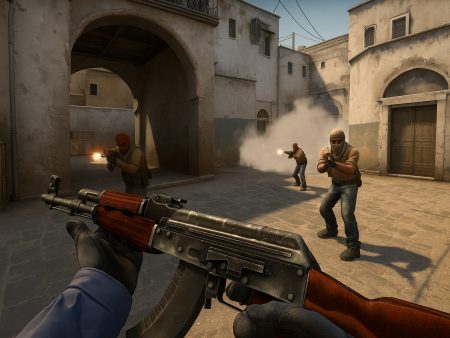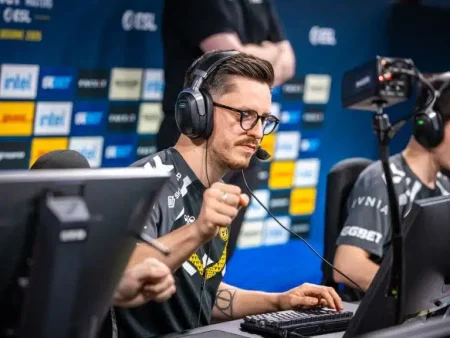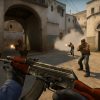Master the art of CT retakes in CS:GO and CS2 with this in-depth strategy guide. Learn pro tips, utility usage, and site-specific tactics to win more post-plant rounds and dominate every match.
When the bomb goes down and the clock is ticking, the game shifts dramatically. As a Counter-Terrorist (CT), your role transitions from defense to calculated offense — it’s time for the retake. Many rounds are won or lost based not on the initial hold but on how well the CT side regroups and reclaims control of the site. In CS:GO and now in CS2, mastering the art of retaking bombsites can elevate your win rate, boost your confidence, and solidify your role as a clutch team player. Let’s break down everything you need to dominate post-plant situations, from reading the scenario to deploying the right utility, and executing the perfect retake.
Understanding the Dynamics of a Retake
What is a Retake in CS:GO/CS2?
A retake occurs when the CT side loses control of a bombsite and must recapture it after the Terrorists (Ts) have planted the bomb. This isn’t just a wild rush back into the site — it’s a calculated strategy, demanding team coordination, utility usage, and perfect timing.
Retaking is often the difference between winning or losing a round. In professional CS, teams often play off-site deliberately, preferring to retake with utility instead of holding risky angles. This proves how critical and common retakes are at all skill levels.
A successful retake involves:
- Identifying remaining Ts and their positions
- Utilizing flashbangs and smokes effectively
- Coordinating entry points with teammates
- Defusing under pressure while securing protection
In CS2, where smoke mechanics have evolved and visibility is more dynamic, retakes have become even more fluid and situationally dependent. Understanding the underlying structure of a retake sets the tone for how you’ll execute it round after round.
Why Retakes Matter More Than You Think
Retaking isn’t just a last resort — it’s a strategic decision. Especially on certain maps like Mirage or Inferno, CTs often opt to play for the retake rather than risk overcommitting early. The reasons?
- Higher survival rate: By falling back and regrouping, CTs can preserve more players.
- Better utility usage: Post-plant situations allow coordinated flashes and smokes that can blind and isolate Ts.
- Element of surprise: With delayed pushes, Ts may get too comfortable and drop their guard.
Plus, successfully retaking gives a massive morale boost, both mentally and economically. It forces Ts to respect your ability to reclaim space, making them think twice before rushing sites mindlessly. For eco or force-buy rounds, a smart retake can completely flip the game.
At the end of the day, knowing when and how to retake is a key marker of a seasoned CT. It’s a decision rooted in game sense, map knowledge, and teamwork.
Reading the Situation Before You Retake
Evaluating Enemy Positioning and Utility
Before rushing in, take a breath — then start piecing the puzzle together. You have more information than you think, and the key to a successful retake lies in interpreting that intel. Ask yourself:
- How many enemies are left?
- Do you know their health or weapons?
- Where were they last seen?
- What utility did they use during their take?
Listen for footsteps, gunfire, and reloads. These audio cues help you triangulate their positions. Maybe one T is hiding in Palace on Mirage, or maybe they’ve double-stacked New Box on Inferno B. Use this knowledge to plan your angles and utility accordingly.
Next, analyze their remaining utility. If the Ts still have molotovs or smokes, they might delay your entry with fire or blind your vision. On the other hand, if you hear the bomb plant and no grenades follow, they’re likely low on utility, giving you an upper hand.
Lastly, always check your radar and minimap. If a teammate dies, his death icon shows where the kill happened. This gives you live updates about enemy positioning — don’t ignore that small square in the corner.
Counting Down the Bomb Timer
In CS2, time is everything. From the moment the bomb is planted, you have 40 seconds to act. That might seem like a lot, but by the time you regroup, rotate, smoke, flash, clear angles, and defuse — it’s tight.
Break it down like this:
- 0–10 seconds: Regroup and rotate to bombsite.
- 10–25 seconds: Execute retake with utility.
- 25–35 seconds: Attempt defuse (with or without kit).
- 35–40 seconds: Clutch or exit.
Always ask: Do we have a defuse kit? Without it, you need 10 full seconds to defuse — a lifetime in CS2. With a kit, it drops to 5 seconds, giving you more margin for error. This can be the make-or-break factor in a retake.
If the timer’s under 10 seconds and you’re not in position or don’t have a kit, it might be time to save your gear. Don’t throw away your AWP or M4 for an impossible clutch — think long-term.
Communicating with Your Team Efficiently
A retake lives and dies by communication. Silence might be golden in some situations, but in CS2, it can be deadly. Here’s what you should be calling:
- Enemy positions (“Two ramp, one default”)
- Utility being used (“Flashing over stairs”)
- Intentions (“I’ll stick the defuse, cover me”)
- Status updates (“I’m on site, one jungle”)
Clear, concise communication avoids confusion. You don’t need to narrate every step — just the essentials. Avoid chaos by letting the IGL (in-game leader) or most vocal player make the final call.
Don’t overtalk either. A single well-placed call like “He’s Firebox, not peeking” can be more valuable than rambling. If you’re dead, only speak if you have confirmed info — not to backseat the round.
Must-Have Utility for Successful Retakes
Smokes, Flashbangs, and Molotovs
Utility is the backbone of any successful retake. In CS2, the improved smoke dynamics and faster tickrate make grenade usage more influential than ever. Think of each grenade as a mini superpower—used properly, it can win you the round. Used poorly, it’s a waste of precious resources.
Let’s break it down:
- Smokes: Essential for cutting off sightlines and isolating angles. A well-placed smoke can:
- Block off common post-plant positions (like A ramp or banana on Inferno)
- Force Ts to reposition or reveal themselves
- Allow safe passage to the bombsite or defuse
- Flashbangs: These are your entry tickets. Pop-flashes help blind Ts holding angles, letting you push without getting one-tapped. The key is coordination—have one teammate flash while others peek instantly.
- Molotovs/Incendiaries: Perfect for clearing common hiding spots like Firebox, Sandbags, or New Box. They also delay pushes or force enemies out of strong positions, making them easier to pick off.
Tips for effective utility use:
- Don’t throw all your nades at once. Stagger them to apply constant pressure.
- Learn bounce flash lineups that hit angles without exposing yourself.
- Always bring at least one flash and one smoke into post-plant scenarios if possible.
Pro tip: One well-timed smoke on the bomb can cause chaos. Enemies have to spam blindly or push to deny the defuse. Combine it with a fake defuse and flash for maximum impact.
Best Spots to Use Utility When Retaking A or B
Utility isn’t just about throwing—it’s about throwing smart. Each bombsite has high-impact spots that can change the flow of a retake. Here’s a breakdown by site:
Mirage A Site
- Smoke CT if enemies are holding jungle or connector.
- Flash over stairs or Tetris to blind anyone hiding near default or Firebox.
- Molotov Firebox or under Balcony to force players out of tough angles.
Inferno B Site
- Smoke Coffins or CT to block vision from back site.
- Flash over ruins or banana to blind anyone watching from dark/new box.
- Molly first oranges to clear tight plant spots.
Dust2 A Site
- Smoke short or long cross depending on where you’re retaking from.
- Flash over long or CT ramp to blind pit or goose.
- Molly Goose or ramp to flush out common plant defenders.
No matter the map, your goal is the same: disorient the enemy while maximizing your team’s chances of safe entry. Always keep in mind your retake direction (CT, connector, banana, short, etc.) and adapt your utility usage to suit it.
Retake Strategies by Bombsite
How to Retake A Site on Mirage
Mirage A site is one of the most commonly contested bombsites, both in matchmaking and pro play. Ts love rushing it, and CTs often play retake from jungle or connector instead of holding deep.
Step-by-step Retake Plan:
- Regroup near CT or jungle — avoid solo peeks from spawn.
- Throw a smoke at Tetris or Ramp to isolate the front of the site.
- Use a flash over triple or stairs — aim to pop-flash close angles.
- One player clears Firebox with a molly, while others clear default and sandwich.
- Once the site is secured, smoke the bomb if needed and cover the defuser from jungle and stairs.
Key Tips:
- Watch out for lurkers in Palace — always check above.
- Use boosts on stairs or ticket booth for off-angles if retaking late.
- Keep track of potential double stack in Firebox or triple.
The most successful retakes here are synchronized, explosive, and ruthless. Don’t delay too long, or the Ts will dig in deep.
Retaking B Site on Inferno: A Tactical Approach
Inferno’s B site is arguably the most difficult site to retake. With so many tight corners and hiding spots, Ts can lock it down with just two players and a few nades. But it’s not impossible.
Step-by-step Retake Plan:
- Approach from CT and coffins — avoid rushing through smoke unless coordinated.
- Smoke New Box or back site to obscure AWP/AK holders.
- Flash over Coffins or ruins, making sure to bounce them above dark or first oranges.
- Molotov Dark, second oranges, and/or emo to force out campers.
- Push together and isolate fights — always trade kills.
Key Tips:
- Avoid peeking solo through banana — Ts often pre-aim or stack banana exit.
- If possible, boost a player over the wall near coffins to get an unexpected angle.
- Utilize a smoke on the bomb and stick the defuse while teammates clear angles.
Inferno B is a battle of nerves, timing, and information. If you lose a player early or can’t coordinate utility, it’s often better to save and fight another round.
Retaking Dust2 A Site: Long vs Short Coordination
Dust2’s A site is iconic, but that doesn’t mean it’s easy to retake. Depending on where you’re coming from — Long or Catwalk (Short) — the approach changes drastically.
Retaking from Long:
- Use a smoke for cross so Ts can’t hold from ramp or goose.
- Flash off the wall near blue to blind pit and ramp.
- Clear pit and car first — Ts often leave a lurker there.
- Once site is cleared, one player holds long while others defuse.
Retaking from Short:
- Smoke ramp or CT, depending on enemy setup.
- Flash over the A site boxes — aim to blind goose and default.
- Molotov Goose — a favorite hiding spot for post-plant Ts.
- Watch for AWPs holding from long or elevator.
Key Tips:
- Coordinate crossfire from Long and Short — pushing at the same time is crucial.
- A well-thrown Molotov on site can delay or deny plants entirely.
- Always have one teammate hold catwalk flank in case of lurkers.
Dust2 retakes are about timing and angles. Peeking without utility or staggering entries is a fast way to lose. Sync up and push hard.
Role Distribution in Retake Scenarios
Entry Fragger vs Lurker vs Support During Retake
Every player on the team has a role during a retake, and understanding that role can turn a chaotic push into a well-oiled machine. Just like during a standard execution, your team should function as a coordinated unit, with each player bringing something to the table.
Entry Fragger:
This player is first in. Their job isn’t necessarily to survive but to create space and take attention away from others. In retake scenarios, the entry fragger needs to:
- Lead the charge through smokes or flashes
- Take wide peeks to bait enemy fire
- Communicate enemy positions immediately after engagement
It’s a high-risk role, but when done right, it allows teammates to clean up while enemies are distracted or repositioning.
Lurker / Flanker:
Although CTs typically don’t “lurk” in a traditional sense during retakes, sometimes one player may arrive from an off-angle, like flanking from long A or banana. This role’s objective is to:
- Catch enemies off guard from behind
- Delay post-plant setups
- Apply pressure from a second angle to split attention
Lurkers should time their flank perfectly with the main retake push. If they arrive too early, they die. Too late, and their teammates lose the fight.
Support:
This role includes anyone throwing utility, holding the kit, or watching teammates’ backs during the retake. A support player will:
- Flash over the top without exposing themselves
- Smoke bomb or cut off sightlines for safe entry
- Protect the defuser during stick attempts
- Call out enemies pushing through smoke or repositioning
When each role is executed properly, the CT retake becomes a powerful, dynamic response that can dismantle even the most solid T post-plant.
Importance of Trade Frags in Retake Situations
Trade fragging is the heartbeat of a successful retake. You’re not always going to win your duel — but if your teammate is right behind you and refrags immediately, your push stays alive.
In post-plant situations, Ts are usually dug into crossfires or tight corners, meaning the first player will often die. This is expected. What matters is how fast the second player reacts.
Golden Rules of Trading in Retakes:
- Enter together: Don’t go in one by one. Stack up and peek angles at the same time.
- Crosshair placement: Always aim where your teammate might die. If he peeks Goose, you pre-aim Goose.
- Clear callouts: The dying player must call exact enemy location fast: “He’s behind triple, not peeking yet!”
In CS2, with improved visibility and new smokes, it’s more important than ever to coordinate trades with precision. Sometimes it’s worth sacrificing one player if you guarantee a trade and control of the site.
If you can chain trade frags together—2 for 1, 3 for 2—you’ll win most retake rounds, even if you started at a man disadvantage.
Practicing Retake Skills Like a Pro
Workshop Maps and Aim Trainers
Retakes aren’t just learned in live matches — they’re sharpened in practice. There are dozens of custom maps and training tools available to boost your performance in post-plant situations.
Top Workshop Maps for Retake Practice:
- YPR Retake Series – These simulate real bombsite retakes with varying setups.
- Aim Botz – While not a retake map, it improves your accuracy for those critical post-plant duels.
- Training_aim_csgo2 – Great for flick shots, reaction time, and headshot drills.
- Crashz’s Smoke Practice Maps – Learn essential smoke lineups for each site.
Spend 15-30 minutes daily running drills. Set specific goals:
- Win 5 retake rounds in a row
- Hit 10 headshots before dying
- Practice 3 different utility lineups for each bombsite
The more comfortable you are with utility execution and fast decision-making, the smoother your real-match retakes will become.
Watching Pro Demos for Retake Tactics
One of the best (and most underused) ways to improve your retake game is by watching professional match demos. Pro teams execute retakes with clockwork precision, and by studying their choices, you’ll start to see patterns.
What to Watch For:
- How do they use utility during retakes?
- How do they coordinate entry? Who leads?
- Do they wait for the 10-second mark or push immediately?
- What spots do they clear first?
- How do they position for trades and defuses?
Teams like Natus Vincere, Vitality, and FaZe Clan are known for their world-class CT sides. Study how ZywOo, s1mple, or ropz handle 1v2 retakes — their timing, utility, and positioning are top tier.
You can use tools like:
- CSGO Demo Manager
- HLTV demo archives
- YouTube POV replays with commentary
Don’t just watch for fun — take notes and even try to replicate the same rounds in your own practice sessions. You’ll start noticing your confidence growing in live games.
Mental Game: Staying Calm Under Pressure
Handling 1vX Retakes and Clutching
Retaking a site alone with multiple enemies alive is daunting — but it’s also a golden chance to become the hero. 1v2s and 1v3s aren’t impossible. The trick lies in your mindset and movement.
Key 1vX Clutch Strategies:
- Avoid noise: Don’t run unless necessary. Sound gives away your position.
- Use utility to isolate fights: One well-placed smoke or molly can turn a 1v3 into a 1v1.
- Play off timings: Wait a few seconds after plant — Ts will relax, expecting you to save.
- Stick the defuse if they don’t check — sometimes the boldest play is the smartest.
Clutches are more about game sense than mechanics. Learn to read your enemies, predict their positions, and punish their overconfidence.
And if you lose? Don’t tilt. Analyze your decisions and move on. You’ll win the next one.
When to Save vs When to Commit
This is one of the hardest decisions in CS2: Should we go for the retake or save our guns?
There are several factors to consider:
- Enemy player count: If it’s 3v5 and bomb is planted, think twice.
- Utility left: No flashes or smokes? You’ll have a tough time breaking a post-plant hold.
- Defuse kits: If nobody has a kit, you need to defuse in 10 seconds — not ideal.
- Money: If you’re broke and carrying an AWP or M4, saving might help next round.
When to Save:
- You’re outnumbered with no utility
- You have expensive guns or a full kit
- Teammates are out of position with little time left
When to Commit:
- Even numbers or man advantage (3v3, 2v2)
- You have utility and a kit
- Losing the round means match point
Be honest with yourself and your team. No shame in saving smart — it’s the economical equivalent of winning.
Common Mistakes to Avoid During Retakes
Poor Utility Usage
One of the fastest ways to sabotage a retake is through misused or mistimed grenades. Utility is your main advantage when storming a bombsite — but if it’s used carelessly, it’s worse than useless.
Common Utility Mistakes:
- Double smokes: Two players throwing smokes on the same spot, wasting one entirely.
- Late molotovs: Mollying after teammates are already entering, possibly blocking them or revealing the retake too early.
- Flash fails: Flashing teammates instead of enemies — especially painful during synchronized pushes.
- Smokes on teammates: Accidentally blinding or cutting off friendly vision during site entry.
Avoid these by:
- Calling your throws (“I’ll smoke jungle,” “Flashing over site now!”)
- Spacing your utility to maintain pressure over several seconds, not all at once.
- Practicing lineups so smokes and flashes land exactly where they’re meant to.
In CS2, where smokes can be temporarily cleared by bullets and grenades, timing becomes everything. Smokes are no longer permanent walls — they’re tools for manipulation. Learn to use that dynamic to your favor.
Peeking Alone Without Support
No matter how sharp your aim is, peeking solo into a 2-man post-plant crossfire is almost always a death sentence. One of the most consistent reasons teams fail retakes is because players try to be heroes, taking on the site alone while teammates are still rotating.
Why Solo Peeking Fails:
- You give Ts a clean 1v1 or crossfire kill.
- No one can trade your death.
- You reveal the CT retake early, allowing the Ts to reposition.
How to Fix It:
- Wait for your team, even if you’re eager to retake.
- Always swing in pairs — one wide, one tight — so you trade kills.
- Use pre-fired angles and sync flashes to blind Ts before the peek.
Even in 1v1 situations, it’s better to peek from an unexpected angle or after a fake flash/smoke rather than rushing in raw. Let Ts make mistakes — you capitalize.
Pro Insights and Meta Trends
How Top Teams Handle Retakes Today
The best CS2 teams have mastered retake coordination to the point where they plan for it on CT-side as part of their setup. Some teams even deliberately avoid early fights on bombsites to preserve players and utility for a retake.
Current Pro Retake Meta Includes:
- 2-man banana control, followed by full retake on Inferno B
- Smoke and flash layering for simultaneous jungle/stairs pushes on Mirage A
- Boosting and off-angles for unexpected post-plant defense breakers
- Coordinated defuse baits, especially when utility is low
Teams like Vitality, G2, and MOUZ have turned retaking into an art form. Watch how they use mid-round utility holds specifically for post-plant contests. Retakes are no longer desperate attempts — they’re orchestrated counter-strikes.
How the Meta is Shifting with CS2 Mechanics
CS2 brings significant mechanical and visual changes, and those shifts are already reshaping how retakes are executed.
What’s Changed:
- Volumetric smokes: Players can shoot through smokes and clear visibility with HE grenades. This means CTs can deny post-plant smoke covers or force visibility on defuse.
- Better tickrate & responsiveness: Peeking and trades are now more precise, making tight retake timing more viable.
- Lighting and sound upgrades: Hearing plant sounds, reloads, or scope toggles is clearer, making info gathering during retakes more accurate.
Because of these updates, the emphasis is now on dynamic utility, team synergy, and split-second execution. Teams that adapt to these changes will dominate the new meta, while those stuck in old CS:GO habits will fall behind.
Conclusion: Mastering the Retake Mindset
Retaking bombsites as a CT in CS:GO or CS2 is no longer just a desperate dash to the bomb. It’s a calculated, strategic, and essential skill that separates elite players from the average. Whether you’re clearing Mirage A, Inferno B, or Dust2 A, the fundamentals remain the same: gather information, use utility smartly, move as a unit, and trade your fights.
More importantly, remember that every retake attempt is a chance to refine your coordination, improve your communication, and demonstrate your understanding of the game’s most pressure-filled moments. When executed right, a retake is not only possible — it’s inevitable.
So the next time the bomb ticks down and your team is regrouping outside the site, take a deep breath, line up your smoke, and get ready to reclaim what’s yours.
FAQs
What’s the best utility combo for a CT retake?
The most effective combo is a smoke on the bomb, a flash to blind post-plant spots, and a molotov to clear common angles like Firebox, emo, or Goose. This forces Ts to move while you push in synchronized.
How can I improve my communication in retake situations?
Focus on clear, short callouts: enemy positions, utility thrown, and what you’re doing. Use phrases like “Flashing over site,” “I’ll defuse,” or “One close triple.” Avoid overtalking or giving unnecessary info.
Are solo retakes worth attempting in CS2?
Only if you have a clear advantage: enemies are low, you have utility and a kit, or they’re out of position. Otherwise, it’s usually smarter to save your gun for the next round — especially if you’re carrying expensive gear.
What’s a good routine to practice retaking?
Spend 20-30 minutes daily on retake maps from the Steam Workshop, practice smoke lineups, and review pro demo POVs. Focus on syncing utility throws and shooting drills from key retake angles.
Do professional players always attempt retakes?
No, pros are selective. They’ll abandon retake attempts if it’s a 2v5, no kits, or no utility. Saving is a strategic move — not a sign of weakness. Knowing when to fight and when to fall back is what makes them elite.












